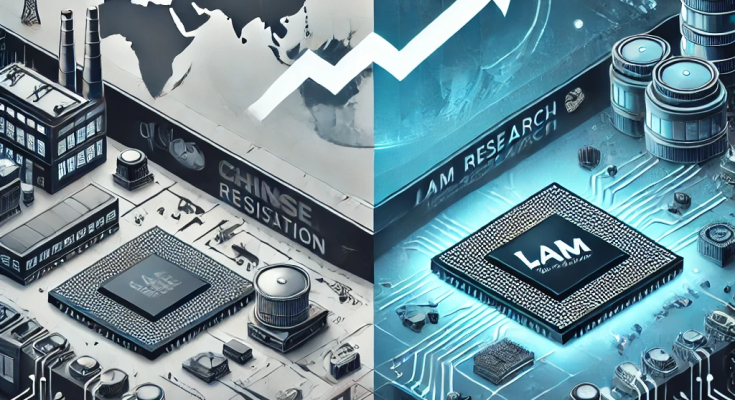Introduction
The global semiconductor industry is undergoing a major shift as geopolitical tensions, trade restrictions, and supply chain adjustments reshape production strategies.
Two key developments highlight these changes:
• China’s chipmaking slowdown: After three consecutive years of growth, China’s acquisition of chipmaking equipment is expected to decline in 2025 due to overcapacity concerns and ongoing U.S. sanctions.
• Lam Research’s $1 billion investment in India: The U.S.-based semiconductor equipment manufacturer is expanding its presence in India, signaling a strategic move to diversify manufacturing hubs amid U.S.-China trade tensions.
These trends indicate a broader realignment of global semiconductor supply chains, affecting chipmakers, manufacturers, and national economies. In this article, we examine why China’s chip industry is slowing down, the significance of Lam Research’s India investment, and what these shifts mean for the future of semiconductor production.
China’s Chipmaking Slowdown: What’s Happening?
1. Overcapacity and Decreasing Demand
For the past several years, China has aggressively expanded its chip manufacturing sector, aiming for self-sufficiency in semiconductor production. However, recent reports suggest that demand is declining, leading to overcapacity issues.
Key factors contributing to the slowdown:
• Sluggish demand for consumer electronics: Global sales of smartphones, laptops, and other chip-heavy devices have slowed, reducing the need for large-scale chip production.
• Inventory buildup: Chinese chipmakers overproduced in previous years, anticipating higher demand that did not fully materialize.
• Declining profit margins: With too many manufacturers competing in the same space, companies are struggling to maintain profitability.
2. Impact of U.S. Sanctions on China’s Chip Industry
The U.S. government has imposed strict sanctions on Chinese chipmakers, limiting their access to:
• Advanced semiconductor manufacturing equipment from U.S. companies like Lam Research and Applied Materials.
• High-performance chips produced by Taiwan’s TSMC and South Korea’s Samsung.
• Critical electronic components needed for AI, military, and data center applications.
These restrictions have hampered China’s ability to produce cutting-edge semiconductors, forcing the country to rely on older-generation chips for domestic production.
As a result, China’s chip imports and purchases of semiconductor equipment are projected to decline in 2025, marking a slowdown in what was once a rapidly growing industry.
Lam Research’s $1 Billion Investment in India: A Strategic Move
1. Why Is Lam Research Expanding to India?
While China’s chip sector slows, other countries are stepping up their semiconductor manufacturing efforts, and India is emerging as a key player.
Lam Research, a major U.S. supplier of chipmaking equipment, has announced a $1 billion investment in India to:
• Set up a semiconductor research and development (R&D) facility.
• Train Indian engineers in advanced chipmaking processes.
• Support India’s growing semiconductor ecosystem.
This investment is part of a broader trend where U.S. chipmakers are shifting supply chains away from China due to trade restrictions and geopolitical risks.
2. India’s Rising Role in the Semiconductor Industry
India has positioned itself as a global alternative for semiconductor manufacturing through initiatives like:
• The India Semiconductor Mission (ISM): A government-backed program offering incentives for chip manufacturers.
• Partnerships with global chipmakers like Intel, Foxconn, and TSMC.
• Tax incentives and infrastructure development to attract semiconductor investment.
With Lam Research joining the movement, India is strengthening its position as a new hub for chip innovation and manufacturing.
3. Benefits of Lam Research’s Expansion in India
Lam Research’s investment will have multiple benefits for India and the global semiconductor industry:
• Job creation: Thousands of new jobs in semiconductor engineering and manufacturing.
• Skill development: Indian universities and tech institutes will gain access to advanced chipmaking technologies.
• Supply chain diversification: Reducing reliance on China and Taiwan for semiconductor production.
• Boosting India’s tech exports: Strengthening India’s position in the global electronics supply chain.
While India still has a long way to go before becoming a major chip production hub, Lam Research’s investment marks a significant step in that direction.
What These Shifts Mean for the Future of Semiconductor Manufacturing
1. The Global Semiconductor Supply Chain Is Reshuffling
• China’s slowdown and U.S. restrictions are forcing companies to diversify supply chains.
• India, Vietnam, and Southeast Asian countries are gaining traction as semiconductor hubs.
• The U.S. and EU are investing heavily in domestic chip production to reduce reliance on Asia.
This shift will reshape global semiconductor power dynamics, with more countries competing for chip dominance.
2. The U.S.-China Chip War Is Intensifying
• The U.S. continues to tighten restrictions on China’s chip industry, limiting access to advanced technology.
• China is investing billions into domestic semiconductor development, but progress is slow due to equipment and material shortages.
• The rivalry between U.S., China, and Taiwan will influence future semiconductor trade policies.
3. AI and Advanced Computing Will Drive Chip Demand
Despite short-term slowdowns, the long-term demand for semiconductors will continue to grow, driven by:
• Artificial Intelligence (AI) and Machine Learning – AI applications require powerful GPUs and specialized AI chips.
• 5G and IoT (Internet of Things) – More connected devices mean higher demand for efficient semiconductors.
• Autonomous Vehicles – Self-driving cars need high-performance chips for real-time processing.
Countries that invest in semiconductor innovation today will be at the forefront of the AI-driven economy.
The global semiconductor industry is undergoing a major transformation, with China’s chipmaking slowdown and Lam Research’s India expansion serving as key indicators of where the market is headed.
Key Takeaways
• China’s semiconductor industry is facing overcapacity issues and U.S. trade restrictions, leading to slower growth in 2025.
• Lam Research is investing $1 billion in India, positioning the country as a rising player in the global chip industry.
• The semiconductor supply chain is diversifying, with more countries investing in domestic manufacturing to reduce reliance on China.
• AI, 5G, and advanced computing will continue driving demand for high-performance chips, making semiconductor innovation a critical industry for the future.
As geopolitical tensions and technological advancements reshape the semiconductor landscape, companies and countries that adapt quickly will emerge as leaders in the next era of digital transformation.

